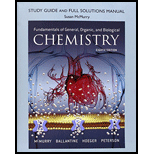
Study Guide And Full Solutions Manual For Fundamentals Of General, Organic, And Biological Chemistry
8th Edition
ISBN: 9780134261379
Author: McMurry, John E., BALLANTINE, David S., HOEGER, Carl A., Peterson, Virginia E., Susan
Publisher: Prentice Hall
expand_more
expand_more
format_list_bulleted
Concept explainers
Question
Chapter 28, Problem 28.85CP
Interpretation Introduction
Interpretation:
The characteristics of steroid hormones in the mechanism of action that shares with the thyroxine have to be explained.
Concept Introduction:
Hormones: Hormones are chemical messengers which are secreted by the cell in endocrine system and are transported along the blood to stimulate the target cells having the corresponding receptors.
Hormones are of three types,
- 1. Amino acid derivatives: It is a derivative of an amino acid formed by the reaction at the side chain functional group, carboxylic acid group, amino group or by the replacement of a hydrogen atom by heteroatom.
- 2. Polypeptides: Polypeptides are organic
polymers having several amino acids attached to each other in a chain. - 3. Steroid: Steroids are a type of organic compound having a molecular structure with four rings connected to each other.
Thyroxine molecule and all the steroid hormones is nonpolar compound so they enter the cell membrane directly by diffusion.
Expert Solution & Answer
Want to see the full answer?
Check out a sample textbook solution
Students have asked these similar questions
What distinguishes peptide hormones from steroid hormones?
Steroid hormones are made up of what molecules? What distinguishes steroid hormones' physical characteristics from those of other hormones?
Do most steroid hormones have cell membrane receptors or intracellular receptors? Why?
Chapter 28 Solutions
Study Guide And Full Solutions Manual For Fundamentals Of General, Organic, And Biological Chemistry
Ch. 28.1 - While thinking about how a messenger molecule and...Ch. 28.2 - Prob. 28.2PCh. 28.2 - Prob. 28.3PCh. 28.2 - Prob. 28.4PCh. 28.3 - Prob. 28.5PCh. 28.3 - Prob. 28.6KCPCh. 28.4 - Prob. 28.7PCh. 28.4 - Look at the structure of thyroxine shown earlier...Ch. 28.4 - Prob. 28.1CIAPCh. 28.4 - Prob. 28.2CIAP
Ch. 28.4 - Prob. 28.9PCh. 28.5 - Prob. 25.10PCh. 28.6 - Prob. 28.11PCh. 28.6 - Prob. 28.12PCh. 28.6 - Prob. 28.13KCPCh. 28.7 - Identify the functional groups present in THC. Is...Ch. 28.7 - Prob. 28.15KCPCh. 28 - Prob. 28.16UKCCh. 28 - Prob. 28.17UKCCh. 28 - Prob. 28.18UKCCh. 28 - Prob. 28.19UKCCh. 28 - Prob. 28.20UKCCh. 28 - Prob. 28.21UKCCh. 28 - Prob. 28.22APCh. 28 - Prob. 28.23APCh. 28 - Prob. 28.24APCh. 28 - Prob. 28.25APCh. 28 - Prob. 28.26APCh. 28 - Prob. 28.27APCh. 28 - Prob. 28.28APCh. 28 - Prob. 28.29APCh. 28 - Prob. 28.30APCh. 28 - Prob. 28.31APCh. 28 - Prob. 28.32APCh. 28 - Prob. 28.34APCh. 28 - Prob. 28.35APCh. 28 - Prob. 28.36APCh. 28 - Prob. 28.37APCh. 28 - How does epinephrine reach its target tissues?Ch. 28 - Prob. 28.39APCh. 28 - Prob. 28.40APCh. 28 - Prob. 28.41APCh. 28 - Prob. 28.42APCh. 28 - What enzyme catalyzes hydrolysis of the second...Ch. 28 - Prob. 28.44APCh. 28 - Prob. 28.45APCh. 28 - Prob. 28.46APCh. 28 - Prob. 28.47APCh. 28 - Prob. 28.48APCh. 28 - Prob. 28.49APCh. 28 - Prob. 28.50APCh. 28 - Prob. 28.51APCh. 28 - Prob. 28.52APCh. 28 - Prob. 28.53APCh. 28 - Prob. 28.54APCh. 28 - Prob. 28.55APCh. 28 - Prob. 28.56APCh. 28 - Prob. 28.57APCh. 28 - Prob. 28.58APCh. 28 - Prob. 28.59APCh. 28 - Prob. 28.60APCh. 28 - Prob. 28.62APCh. 28 - Prob. 28.63APCh. 28 - Prob. 28.64APCh. 28 - Prob. 28.65APCh. 28 - Prob. 28.66APCh. 28 - Prob. 28.67APCh. 28 - Prob. 28.68APCh. 28 - Prob. 28.69APCh. 28 - Prob. 28.70APCh. 28 - Prob. 28.71APCh. 28 - Prob. 28.72APCh. 28 - Prob. 28.73APCh. 28 - Prob. 28.74APCh. 28 - Prob. 28.75APCh. 28 - Prob. 28.76APCh. 28 - Why do we have brain receptors that respond to...Ch. 28 - Prob. 28.78APCh. 28 - Prob. 28.79APCh. 28 - Prob. 28.80APCh. 28 - Prob. 28.81APCh. 28 - Prob. 28.82APCh. 28 - Prob. 28.83CPCh. 28 - Prob. 28.84CPCh. 28 - Prob. 28.85CPCh. 28 - Prob. 28.86CPCh. 28 - Prob. 28.87CPCh. 28 - Prob. 28.88CPCh. 28 - Prob. 28.89CPCh. 28 - Prob. 28.90CPCh. 28 - Prob. 28.91CPCh. 28 - Prob. 28.92CPCh. 28 - Prob. 28.93CPCh. 28 - Prob. 28.94GPCh. 28 - Prob. 28.95GP
Knowledge Booster
Learn more about
Need a deep-dive on the concept behind this application? Look no further. Learn more about this topic, biochemistry and related others by exploring similar questions and additional content below.Similar questions
- What is the mechanism of action of a hormone that cyclic AMP as a second messenger?arrow_forwardEach steroidogenic organ has all the enzymes necessary to produce any steroid hormone. (True or false?)arrow_forwardA physician sees a patient whose symptoms include sluggishness, depression, and intolerance to cold. After eliminating other possible causes, the doctor diagnoses a hormone problem. What disorder fits the symptoms? Why does the doctor suspect that the underlying cause is a malfunction of the anterior pituitary gland?arrow_forward
arrow_back_ios
arrow_forward_ios
Recommended textbooks for you
 Biology (MindTap Course List)BiologyISBN:9781337392938Author:Eldra Solomon, Charles Martin, Diana W. Martin, Linda R. BergPublisher:Cengage Learning
Biology (MindTap Course List)BiologyISBN:9781337392938Author:Eldra Solomon, Charles Martin, Diana W. Martin, Linda R. BergPublisher:Cengage Learning Human Physiology: From Cells to Systems (MindTap ...BiologyISBN:9781285866932Author:Lauralee SherwoodPublisher:Cengage Learning
Human Physiology: From Cells to Systems (MindTap ...BiologyISBN:9781285866932Author:Lauralee SherwoodPublisher:Cengage Learning Biology: The Dynamic Science (MindTap Course List)BiologyISBN:9781305389892Author:Peter J. Russell, Paul E. Hertz, Beverly McMillanPublisher:Cengage Learning
Biology: The Dynamic Science (MindTap Course List)BiologyISBN:9781305389892Author:Peter J. Russell, Paul E. Hertz, Beverly McMillanPublisher:Cengage Learning- Essentials of Pharmacology for Health ProfessionsNursingISBN:9781305441620Author:WOODROWPublisher:Cengage
 Human Biology (MindTap Course List)BiologyISBN:9781305112100Author:Cecie Starr, Beverly McMillanPublisher:Cengage Learning
Human Biology (MindTap Course List)BiologyISBN:9781305112100Author:Cecie Starr, Beverly McMillanPublisher:Cengage Learning

Biology (MindTap Course List)
Biology
ISBN:9781337392938
Author:Eldra Solomon, Charles Martin, Diana W. Martin, Linda R. Berg
Publisher:Cengage Learning

Human Physiology: From Cells to Systems (MindTap ...
Biology
ISBN:9781285866932
Author:Lauralee Sherwood
Publisher:Cengage Learning

Biology: The Dynamic Science (MindTap Course List)
Biology
ISBN:9781305389892
Author:Peter J. Russell, Paul E. Hertz, Beverly McMillan
Publisher:Cengage Learning

Essentials of Pharmacology for Health Professions
Nursing
ISBN:9781305441620
Author:WOODROW
Publisher:Cengage

Human Biology (MindTap Course List)
Biology
ISBN:9781305112100
Author:Cecie Starr, Beverly McMillan
Publisher:Cengage Learning